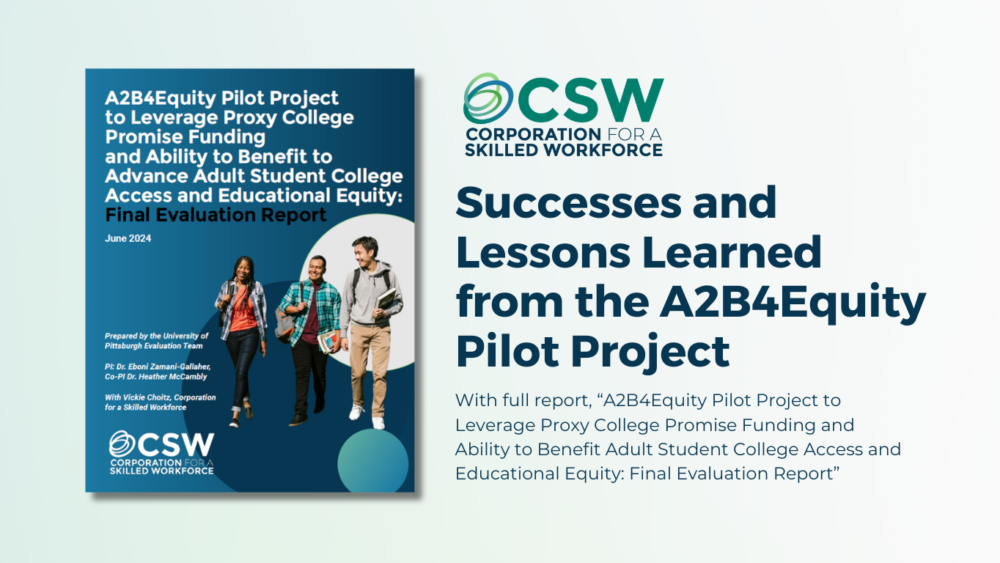Increasingly, colleges, states, and foundations are seeking and adopting innovative strategies to support adult students earning postsecondary credentials. One promising strategy is the credit hour Ability to Benefit (ATB) provision in the federal student financial aid program. In the credit hour ATB provision, adult students who have not yet earned a high school diploma or equivalent dual-enroll in adult education and a postsecondary education program to earn both credentials simultaneously and more efficiently. Under the credit hour ATB provision, once a student completes six credit hours in an eligible career pathway program, they qualify to apply for federal student financial aid, even if they have not yet earned their high school credential.
This provision can open doors to postsecondary education for millions of adult education students, enabling them to earn credentials to access family-supporting employment and contribute to the economic growth of their communities and states. Given the inequality documented in secondary and postsecondary education access, quality, and outcomes, ATB can also promote more equitable postsecondary access and success by providing essential funding, student supports, and more effective programs for students.
Finding Solutions for ATB Challenges
Even though ATB has great potential to support adult students in accessing and succeeding in postsecondary education, colleges and states are hesitant to adopt the strategy for three reasons:
- Uncertainty about the stability of the program and the regulations guiding its implementation
- Questions around whether adult students without a high school credential can succeed in postsecondary education
- Uncertainty of how to fund the first six credit hours of postsecondary education for students with limited financial means, without financial aid
As to the first question, it is true that the federal ATB policy has been somewhat in flux over the last decade—with Congress cutting the provision in 2012 and reinstating it in 2014—and guidance from the US Department of Education has been scant. However, since the reinstatement of ATB in federal law, Congress and the department have reaffirmed it as law and clarified ATB regulations. Updated ATB regulations were issued in October 2023, and went into effect as recently as July 1, 2024. And the US Department of Education issued Dear Colleague letters in May 2024 and June 2024 to provide more detail on the regulations.
In 2022, CSW launched a pilot program funded by ECMC Foundation that helps to answer the second two questions. CSW managed the A2B4Equity pilot project in partnership with the University of Pittsburgh School of Education, who performed the evaluation of the pilot project. World Education, a division of JSI, provided technical assistance to the four participating community colleges—Truman and Daley colleges in the City Colleges of Chicago system and Mott Community College and Wayne County Community College District in Michigan. The pilot’s goal was to provide proxy funding for college promise funds to test using such funding to pay for the first six credit hours adult students need to earn under ATB before they can apply for federal student financial aid to cover the remainder of their postsecondary education.
Key Lessons from the A2B4Equity Pilot Project
1. Adult students from communities of color who lack a high school credential can earn postsecondary credits in career pathway programs.
The pilot aimed to enroll 100 students in approved career pathways programs, 75% being Black and/or Hispanic or from another underserved student racial and/or ethnic group, and 80% completing the necessary six credit hours to access student aid. By the end of the pilot project in June 2024, 105 students had enrolled across the four colleges, 87% were from communities of color, and 79% had completed six credit hours of postsecondary education in an approved career pathway program. The students in this pilot project demonstrated that, indeed, they do have the “ability to benefit” from postsecondary education, per the name and spirit of this federal law.
2. Multiple key departments from across the college must be engaged in, committed to, and coordinated throughout an ATB program for it to succeed, especially the student financial aid department.
By law, the eligible career pathway programs authorized under the ATB provision require a variety of components that typically span different college departments. The department providing workforce training and/or academic credentialed education must be at the table, as well as the department or partner providing the integrated adult education. The department(s) and/or partner(s) providing student counseling, supports, and workforce development activities must be at the table. The student financial aid department is the lynchpin for the entire program, so must be engaged and committed. Coordinating all these entities requires a strong program manager and, usually, college leadership championing this innovation that will take time and effort to get started.
A hard-learned lesson in the A2B4Equity pilot project was that, when the student financial aid department was not engaged early, students did not access federal student financial aid, negating the whole point of the program. Colleges that did engage staff from this department early—including getting department director buy-in, inviting student aid staff into career pathway program classrooms to provide information on student aid early, coordinating with staff to provide assistance to students in completing the student aid form—saw more success in students accessing aid. At the City Colleges of Chicago colleges, 90% of students who enrolled in eligible career pathway programs were able to complete; however, no students accessed student aid because the financial aid staff had not been brought to the table early enough.
At Mott Community College in Flint, Michigan, 73% of enrolled students completed the required six credit hours, and 100% applied for student aid by the end of the pilot period (the pilot project ended before the evaluation team could measure how many students received aid). At Wayne County Community College District in Detroit, 52% of enrolled students completed and 46% applied for student aid. The Michigan colleges engaged their student financial aid office early and often throughout their pilot project, which bolstered financial aid applications.
3. ATB programs need additional funding for both the six credit hours adult students take before being able to access federal student aid and for additional staff to manage the career pathway program components and support students.
The purpose of this pilot project was to use proxy funds from a foundation to test whether a funding source like college promise funds could be used to pay for the first six credit hours for ATB students. We learned that, yes, such a funding source to support student tuition and fees would be valuable in an ATB program. We also learned that some additional funding is required to support additional staffing necessitated by ATB programs.
City Colleges of Chicago used dedicated institutional funds to pay for the tuition and fees for ATB students in their pre-existing eligible career pathway programs. They also had staff already in place to manage these programs and support students. However, the participating colleges experienced staff turnover and vacancies through much of the pilot project, which contributed to the challenge described above around connecting with student financial aid. Mott Community College and Wayne County Community College District used grant funding to support students with tuition, fees, books, etc., and to support staff in starting and implementing the pilot.
Colleges vary to the degree they have the required ATB career pathway program components in place; therefore, states, college systems, or foundations interested in supporting ATB programs should assess what’s already funded and what more needs to be funded to establish an ATB program, taking into consideration additional student support staff that might be required if adding a significant number of ATB students.
Final Evaluation Report
The A2B4Equity pilot project might be summed up in one sentence: ATB students can prove their ability to benefit from college, and colleges need commitment and additional support to successfully implement ATB programs.
More information on the pilot, participating colleges, and outcomes can be found in the final evaluation report written by the evaluation team at the University of Pittsburgh School of Education. CSW also wrote a how-to guide to support colleges and their partners interested in implementing a credit hour ATB program: The Unsung Student Aid Option: A College Leader’s Guide to Implementing the Credit-Hour Ability to Benefit Provision in the Federal Student Aid Program. The project team also hosted a national webinar on the pilot and lessons learned, featuring staff from the participating colleges sharing their insights. For more information about the recent regulations for ATB programs, see World Education’s, a division of JSI, ATB resource page.
Additional Resources
Meet the Author
Vickie Choitz
Vickie Choitz is the Director of Trauma and Resilience at Work. The CSW Trauma and Resilience at Work team advances workplaces and workforces that are culturally responsive, trauma-informed, healing-centered, resilience-building, and supportive of mental well-being.




Comments are closed.